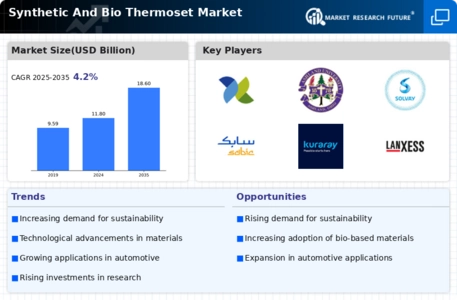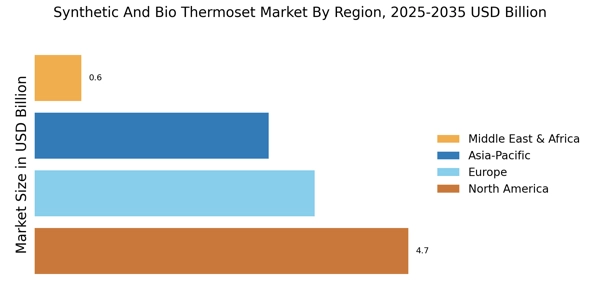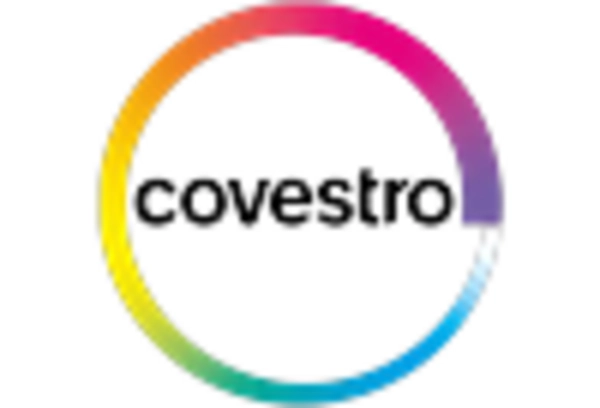Regulatory Compliance
Regulatory frameworks are increasingly influencing the Synthetic And Bio Thermoset Market. Governments worldwide are implementing stringent regulations aimed at reducing environmental impact and promoting the use of sustainable materials. Compliance with these regulations is becoming essential for manufacturers, as non-compliance could result in significant penalties and loss of market access. In 2025, it is expected that the demand for compliant thermoset products will rise, particularly in industries such as construction and automotive, where safety and environmental standards are paramount. This regulatory pressure is likely to drive innovation, as companies seek to develop new formulations that meet or exceed these standards. As a result, the Synthetic And Bio Thermoset Market may experience a shift towards more sustainable and compliant product offerings, ultimately benefiting both manufacturers and consumers.
Technological Innovations
Technological advancements play a crucial role in shaping the Synthetic And Bio Thermoset Market. Innovations in material science have led to the development of high-performance thermosets that exhibit superior mechanical properties and thermal stability. For instance, the introduction of advanced curing agents and additives has enhanced the processing capabilities of these materials, making them suitable for a wider range of applications. In 2025, the market is expected to witness a surge in demand for thermosets that can withstand extreme conditions, particularly in aerospace and automotive sectors. Furthermore, the integration of smart technologies, such as sensors within thermoset composites, is anticipated to create new opportunities for growth. This technological evolution not only improves product performance but also drives competitive advantage for manufacturers in the Synthetic And Bio Thermoset Market.
Sustainability Initiatives
The increasing emphasis on sustainability is a pivotal driver for the Synthetic And Bio Thermoset Market. As industries strive to reduce their carbon footprint, the demand for bio-based thermosets is on the rise. These materials, derived from renewable resources, offer an eco-friendly alternative to traditional synthetic options. In 2025, the market for bio-based thermosets is projected to grow significantly, with estimates suggesting a compound annual growth rate of over 10%. This shift not only aligns with global sustainability goals but also attracts consumers who prioritize environmentally responsible products. Consequently, manufacturers are investing in research and development to innovate and enhance the performance of bio-based thermosets, thereby expanding their applications across various sectors, including automotive, construction, and electronics.
Market Expansion Opportunities
The Synthetic And Bio Thermoset Market is poised for expansion, driven by emerging markets and increasing applications. As developing economies continue to industrialize, the demand for durable and high-performance materials is expected to rise. In 2025, regions such as Asia-Pacific and Latin America are projected to witness significant growth in thermoset consumption, particularly in construction and automotive sectors. This expansion is further fueled by the rising middle class and urbanization, which are increasing the need for advanced materials. Additionally, the versatility of thermosets allows for their application in various industries, including electronics and renewable energy. As manufacturers explore these new markets, they are likely to adapt their product offerings to meet local demands, thereby enhancing their competitive positioning in the Synthetic And Bio Thermoset Market.
Consumer Demand for Customization
The growing consumer demand for customized products is a notable driver in the Synthetic And Bio Thermoset Market. As industries evolve, there is an increasing need for materials that can be tailored to specific applications and performance requirements. This trend is particularly evident in sectors such as automotive and aerospace, where bespoke solutions are essential for optimizing performance and efficiency. In 2025, it is anticipated that manufacturers will invest in flexible production processes to accommodate this demand for customization. This shift not only enhances customer satisfaction but also allows companies to differentiate themselves in a competitive market. By leveraging advanced manufacturing techniques, such as additive manufacturing and precision molding, the Synthetic And Bio Thermoset Market is likely to see a rise in innovative, customized thermoset solutions that cater to diverse consumer needs.


















Leave a Comment